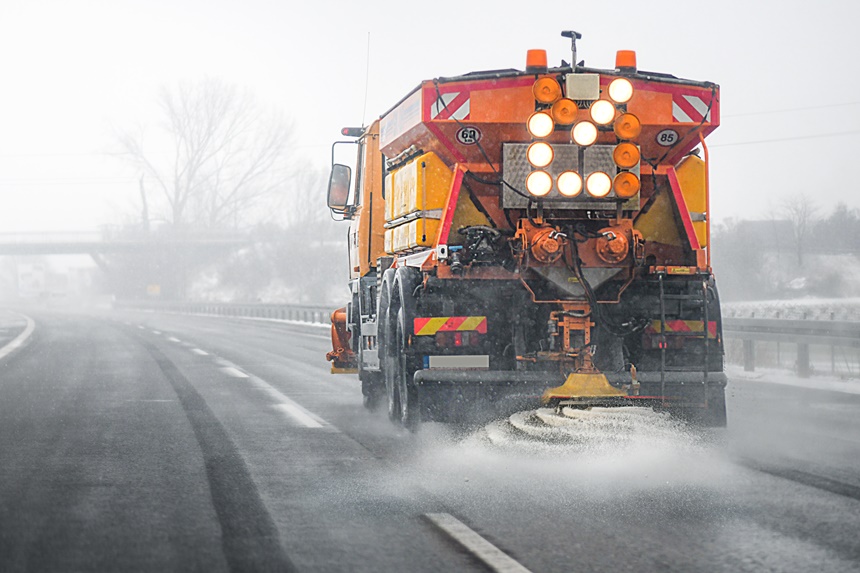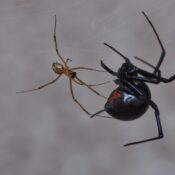The slushie, a semi-frozen treat made from crushed ice infused with colored syrup, has been around for at least 60 years. Its popularity has endured, even though varieties are few and fruity. However, many northern states have introduced bold new selections such as provolone, pickle, and beet-flavored slush. If you want to try it, the catch is you’ll have to scrape it off a highway, which is dangerous and unhygienic, so I don’t recommend it.
Spreading food by-products on icy roads to make them safer is part of a new lower-salt diet aimed at protecting a range of vital elements that include trees, fish, and drinking water as well as cars, bridges, and buildings. These have been a-salted for decades by the world’s most popular de-icing agent, sodium chloride. You might recognize this as the salt we sprinkle on food. Turns out it’s the same stuff we broadcast on sidewalks, streets, and freeways to melt ice, too.
While sodium chloride is cheap and plentiful, it corrodes steel and concrete. In large amounts, it’s toxic to trees and other plants, as well as to aquatic life. Road salt can even pollute wells and make us ill. But we’ve come to depend on de-iced roads for safety and convenience. If there’s no way to melt snow, it packs down to become an ice layer in spite of regular plowing.
Until the 1940s, there were few options for motorists in wintry weather. Drivers could creep along safely using tire chains (which are still mandatory on snowy highways, where posted, in Colorado, Montana, Washington, and several other states), or drive normally and crash.
New Hampshire, whose alternate motto could have been “Live Free and Drive Fast,” broke the ice with road-salt use in 1938, being the first to try sodium chloride on winter roads. The results were breath-taking (or maybe that was partly from cold weather), because by 1942, 5,000 tons per year were already being used across the U.S. These days, we go through 20 million tons every winter. It serves us well, as de-icing salt reduces winter collisions by as much as 88 percent.
At the same time, salt exacts a high toll. It degrades car frames and other steel parts, costing us $3.5 to $7 billion annually. Damage to bridges and roads is estimated at $14 to $19 billion per year, and historic concrete buildings are crumbling due to road salt.
In addition, road salt can taint drinking water. A 2008 study in Dutchess County, New York, showed nearly half the wells surveyed had salt levels exceeding health guidelines, and 20 percent had enough to induce high blood pressure. A follow-up 2018 study found 70 percent of affected households had stopped using their water due to the salty taste. For context, the U.S. EPA recommends a limit of 30 parts per million (ppm) of salt in drinking water (20 ppm for low-sodium diets), while the taste threshold is usually 150-200 ppm.
Each spring we see evergreen foliage burned by salt spray. And since 15-30 percent of de-icing salt bounces off the road, it impacts soils, too, making it hard for plants to thrive. Spring runoff carries salt-laden water into brooks and rivers, harming fish, frogs, and turtles.
With so many problems, one might ask why salt remains our favorite de-icer. The answer is cost. Sodium chloride is far less expensive than alternatives like calcium magnesium acetate, which is easier on vehicles and more eco-friendly.
This is where cheese, beet, and pickle brines are our friends. While granular road salt is a de-icer, brine is an anti-icer when applied to pavement before storms. Once dry, the residue acts as a barrier, keeping snow and ice from bonding to road surfaces. In some cases, brine is employed to wet-down salt as it leaves the truck. Moistened salt granules stick to roads better and don’t bounce as far.
Food brines are superior to salt in that practically no brine leaves the roadway. Also, they contain both salt and sugars, which act in concert to melt ice at temperatures well below 15° Fahrenheit, the effective lower limit of sodium chloride alone. In spring, bacteria and fungi degrade brine-based sugars into carbon dioxide and water. The toxic sodium and chloride of road salt cannot be broken down further, and will persist in the environment.
Additionally, replacing a portion of road salt with food brine means a big net reduction in salt runoff. Overall, using these tasty anti-icers mean fewer adverse effects on plants and aquatic life.
In the “cheese state” of Wisconsin, it’s only natural that whey, a brine left over from the cheese-making process, is the most prevalent liquid anti-icer. The public-works department in Milwaukee is partial to brines from provolone and mozzarella, which they say have ideal salt concentrations. Although city officials claim no one gripes about the smell (or taste) of cheesy slush, it is after all a region that produces half the cheddar consumed in America, so maybe residents are used to it.
In Pennsylvania, home to pickle-making giant H.J. Heinz Company, pickle brine is commonly sprayed on highways by the PA Department of Transportation. Cheese whey and /or beet juice is sometimes mixed in as well. Across Ohio, beet slush began turning up in Cleveland around 2007, and is now a cold-weather staple in Dayton, Akron, and other towns and cities. Homeowners can buy beet-juice ice melting products, too.
As long as motorists expect to drive at full speed in winter, we’ll always need de-icing agents. Ask your municipality if they’d consider using food brines instead of salt. Just don’t eat those road slushies.
Become a Saturday Evening Post member and enjoy unlimited access. Subscribe now



